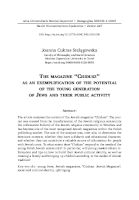The magazine “Chidusz” as an exemplification of the potential of the young generation of Jews and their public activity
Author(s)
Publication Name
Publication Date
Abstract
The article analyses the content of the Jewish magazine “Chidusz”. The journal was created from the transformation of the Jewish religious community the information bulletin of the Jewish religious community in Wrocław and has become one of the most recognised Jewish magazines within the Polish
publishing market. The aim of the analysis was, inter alia, to determine the dominant contexts, whether they have a didactic and educational character, and whether they can constitute a valuable source of information for people
with Jewish roots. To what extent does “Chidusz” respond to the needs of the young Polish Jewish community? In particular, will young readers obtain information and tips on how to build their Jewish cultural identity, as well as
creating a family and bringing up children according to the model of Jewish tradition?
publishing market. The aim of the analysis was, inter alia, to determine the dominant contexts, whether they have a didactic and educational character, and whether they can constitute a valuable source of information for people
with Jewish roots. To what extent does “Chidusz” respond to the needs of the young Polish Jewish community? In particular, will young readers obtain information and tips on how to build their Jewish cultural identity, as well as
creating a family and bringing up children according to the model of Jewish tradition?
Topics
Jewish Community Main Topic: Identity and Community Jewish Media Newspapers, Magazines and Periodicals Youth Jewish Revival
Genre
Geographic Coverage
Copyright Info
The periodical offers access to content in the Open Access system under the terms of a Creative Commons non-exclusive license (CC BY-ND 3.0).
Original Language
Volume/Issue
37(1)
Page Number / Article Number
131-142
DOI
Link
Download can be found on page, The magazine “Chidusz” as an exemplification of the potential of the young generation of Jews and their public activity
Bibliographic Information
The magazine “Chidusz” as an exemplification of the potential of the young generation of Jews and their public activity. 2019: 131-142. https://archive.jpr.org.uk/10.12775/AUNC_PED.2019.008




